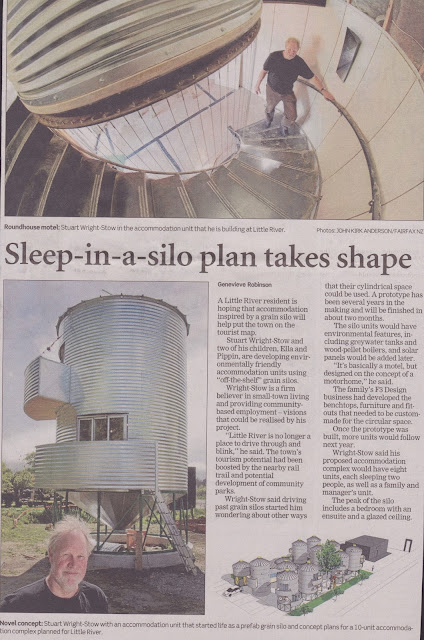A few of my articles are below: (the rest were not the correct file type - will add more soon)
Gallic Flair: An article on French woman, Martine Marshall-Durieux and her love for all things French.
Glories Revived: A feature on Christchurch's "quirky" home store, The Painted Room
Sleep-in-a-silo: Little River eco-style accommodation for travelers
Editorial for Childrens' Tables and Chairs for Metropol:
An article written for The Star, Dunedin at the time of the professional firefighters Fire Strike of 2011.
Feature on Dr Jeffrey Wigand on NZ's Smokefree by 2025.
Whistle-blowing
tobacco scientist Jeffrey Wigand says New
Zealand
could lead the world in smoking cessation
| By Genevieve Robinson | Category: Lead story, News
NZ can be smoke free,
whistle-blowing insider says:
Tight border controls and having more than 80 per cent of
tobacco products imported from Australia will help New Zealand be smoke-free by
2025, tobacco scientist and industry whistle-blower Jeffrey Wigand says.
But to get there, the country needed to develop strategies
to minimise the impact of cigarette and tobacco product packaging by making
them image-free, and remove all shop displays and advertising, Dr Wigand said.
Whistle-blowing tobacco scientist Jeffrey Wigand believes
New Zealand could lead the world in smoking cessation
“Out of the top ten recognised logos in the world, Marlboro
is recognised more than anything else,” Dr Wigand told Newsline from his office
in his Michigan home.
“More than McDonalds. More than Disneyland’s Mickey Mouse.”
Dr Wigand shot to prominence in the early 90s when he became
the most senior tobacco company executive to claim his former employer
manipulated tobacco ingredients to maximise nicotine in cigarettes.
His stand made him subject of the Russell Crowe film The
Insider, which detailed his public testimony and his claims that he received
death threats as a result of what he was prepared to say.
Today, the former research and development chief for Brown
& Williamson Tobacco Corporation is founder of Smoke Free Kids, a
Michigan-based non-profit foundation that educates children on the dangers of
smoking.
He also provides technical input to governmental
organisations interested in regulating tobacco products and creating smoke-free
environments worldwide.
Dr Wigand visited New Zealand in 2010 to give expert advice
before the Parliament’s Maori Affairs Committee’s inquiry into the tobacco
industry.
He told Newsline New Zealand was an isolated country with
well-defined borders and no known tobacco trafficking problems. It had the
“ideal opportunity” to do things that other countries, such as the United
States, were unable to do.
New Zealand’s plans to be smoke-free by 2025 could “set the
stage for what I would call ‘best practices’”, he said.
The tobacco industry used packaging as an advertising tool,
and the government needed to “stop new users in their tracks” by targeting
advertising and providing robust cessation programs.
It needed to create programs that provided free and,
crucially, nicotine-free cessation options for smokers trying to quit.
Nicotine-laden cure-alls should not be considered a
legitimate form of cessation. He believed nicotine was not safe and should
never be used in a device claiming to aid cessation.
“Nicotine by itself is a toxin and a poison,” Dr Wigand
said.
“For someone to say that nicotine is safer is just not true.
There is only one reason to buy nicotine. That’s to create an addiction. Okay.”
Nicotine-based cessation simply offered another form of
addiction.
“And if you say you now have a safer form of addiction, what
does it do to someone who is worried about the health risks?
“It encourages people not to quit, and it encourages people
to start.
“I use it [nicotine] as an insecticide on my rose bushes.”
Only 12 per cent of smokers could quit cold turkey.
Gum-and-patch techniques worked for some people but often
had to be used in conjunction with antidepressants.
A new, nicotine-free product called Champix blocks the
brain’s nicotine receptors so that smokers would no longer like the taste of
cigarettes.
Such a product should be promoted by governments serious
about smoking cessation.
Being smoke free by 2025 could benefit many New Zealanders –
smokers and non-smokers alike.
Dr Wigand referred to Ministry of Health and ASH New Zealand
data, which showed smoking killed around 50 per cent of all users.
He said the public often did not recognise the risks of
second-hand smoke, and that creating a smoke-free environment was the only way
to stop the risks.
“Well, we know that second-hand smoke kills, [and] there is
no safe level of a carcinogen.
“You have second-hand smoke, you expose people to heart
disease, heart attacks and you also expose them to breast cancer.”
A Californian report showed there was a 30 per cent increase
in breast cancer in non-smoking, pre-menopausal women who were exposed to
second-hand smoke in a bar.
Dr Wigand said a carcinogen such as second-hand smoke was
not dose dependent.
ENDS
Article in The Press:









No comments:
Post a Comment